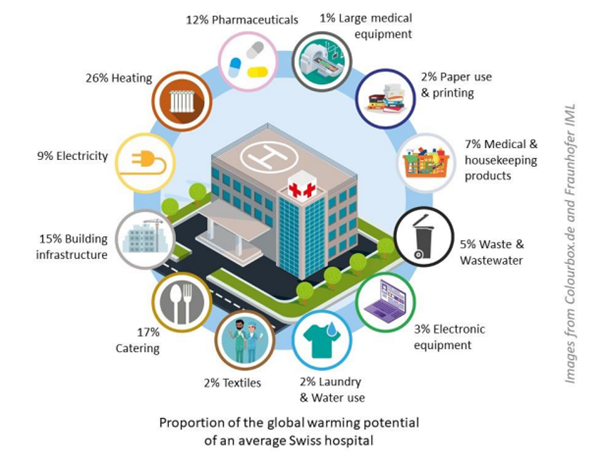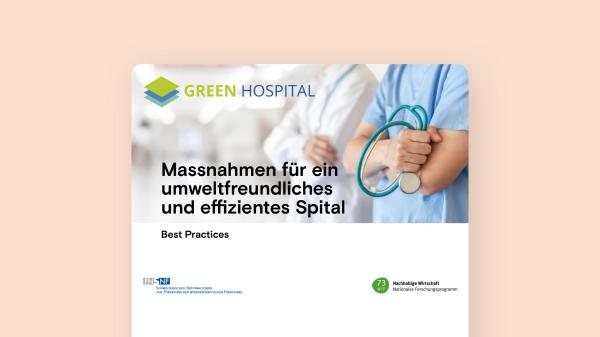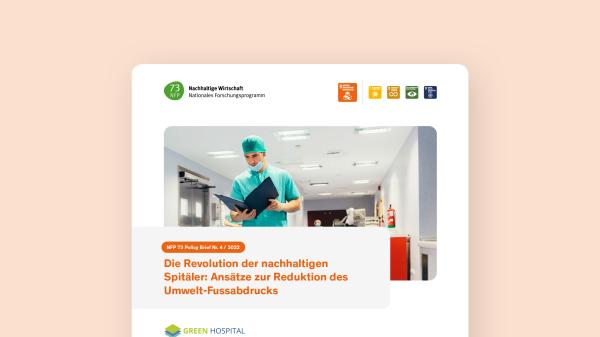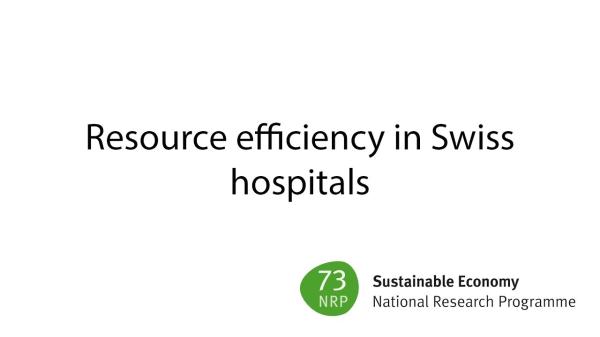Resource efficiency in Swiss hospitals
Which processes in a hospital have a particularly high environmental impact and how can they be made more sustainable while respecting the needs of patients and employees? This project collected primary data and analysed relevant hospital processes together with partner hospitals from an environmental and logistic perspective.

Background
The consumption of healthcare and social services is the fourth most important area of consumption from an environmental perspective, after food, mobility and housing. However, there are barely any comprehensive environmental assessments of this area. Before this project, it was not clear where the biggest levers for possible improvements lay, and how they could be implemented. No analysis of the environmental efficiency of hospitals had been conducted and the areas with the greatest improvement potential had not been identified.
Aim
The project aimed at developing consistent and comprehensive knowledge about resource consumption and environmental impact in Swiss hospitals. To this end, we analysed the factors that determine the life cycle environmental impact of the healthcare sector as well as resource efficiency in hospitals. These results served as a basis for the development of best practices for the sustainable and efficient operation of hospitals in Switzerland.
Results
The analysed areas in hospitals were electricity, heating, catering, building infrastructure, laundry, water use, waste and wastewater, textiles, medical products, housekeeping products, paper use and printing, pharmaceuticals, electronic equipment and large medical equipment.
Key areas for increasing sustainability in hospitals
Our life cycle assessment of the environmental impact of these 14 areas in 33 Swiss hospitals showed: the areas catering, building infrastructure, heating, electricity and pharmaceuticals together account for about 70% of the Swiss hospitals’ impact on climate change through greenhouse gas emissions. The same areas are also responsible for about 70% of overall environmental impact according to the Swiss Ecological Scarcity Method. This method assesses the impact of pollutant emissions and resource extraction activities on the environment as part of a life cycle assessment.
Aspects included in the sustainability analysis
It reflects both the actual emission situation and the national or international emissions targets pursued by Switzerland. Some of the aspects considered are energy and mineral resource depletion, air pollution, water and soil, land use and climate change. The production of large medical equipment, housekeeping products and medical products as well as laundry, paper and printing, and water use each contributed less than 4% to both climate and environmental impact. The environmental efficiency analysis – using Data Envelopment Analysis (DEA) as well as Stochastic Frontier Analysis (SFA) – revealed that half of the hospitals could decrease their environmental impact by at least 50% without reducing their health service output.
Optimisation potential in hospitals to increase sustainability
Taking into account both the efficiency and environmental relevance of the areas, the highest improvement potentials are also in the areas of building infrastructure, catering, heating, electricity and pharmaceuticals, followed by waste and waste water. The biggest improvement potential in hospitals can be found in the area of heating. Improving the average efficiency of all hopitals in terms of heating by one percentage point would reduce the overall global warming potential (GWP) by 0.6 % or almost 1,700 tonnes CO2eq per year. For the entire Swiss acute care hospital sector, the total greenhouse gas emissions, including the full life cycle, are estimated at 445,000 tonnes CO2eq per year. This corresponds to 20.43 t CO2eq per standardised revenue in CHF or 3.26 t CO2eq per health care services provided by one full-time equivalent (FTE) healthcare professional in one year.
Sustainability potential in logistics
An on-site process analysis revealed that an optimisation of logistics is possible in all hospitals studied, for example by streamlining the ordering process for units by specifying an order quantity, training staff to avoid waste of cleaning cloths and offering more vegetarian meals by providing more plant-based options and changing the default meal.

Implications for research
Research conducted under the project led to the first scientific publication on life cycle assessment results of hospitals based on bottom-up inventory data. The developed comparison unit of standardised revenue provides a new approach to calculating a value representing provided healthcare services. This makes it possible to compare the environmental impact of different healthcare providers, representing a valuable alternative to the comparison of healthcare services based on the number of beds, hospital days or the number of patients, since standardised revenue includes both inpatient and outpatient treatments and corrects for regional differences. Hence, the comparison unit and results can be used as reference for international publications and will guide future research on hospital life cycle assessment by taking into account the sustainability relevance of hospital areas.
Implications for practice
The on-site process analysis revealed an improvement potential for cleaning and procurement processes. Every hospital can benefit from a systematic analysis of its operational processes. Identifying the areas with the biggest potential for resource efficiency improvements, the environmental efficiency analysis made it possible to improve sustainibility initiatives in the hospital sector. Interactive networking workshops led to new collaborations, e.g. between several hospital sustainability managers. Their strong interest in the topic highlights the importance of exchanging ideas about sustainability measures.
Publications
Project leaders
Matthias Stucki
Institut für Umwelt und Natürliche Ressourcen
Zürcher Hochschule für Angewandte Wissenschaften (ZHAW)
Dr. Stefan Meyer
Institut für Wirtschaftsstudien
Basel IWSB
Dr. Sebastian Wibbeling
Fraunhofer-Institut für Materialfluss und Logistik
IML, Deutschland
Project partners
GZO Spital Wetzikon
Hirslanden Group
Inselspital




